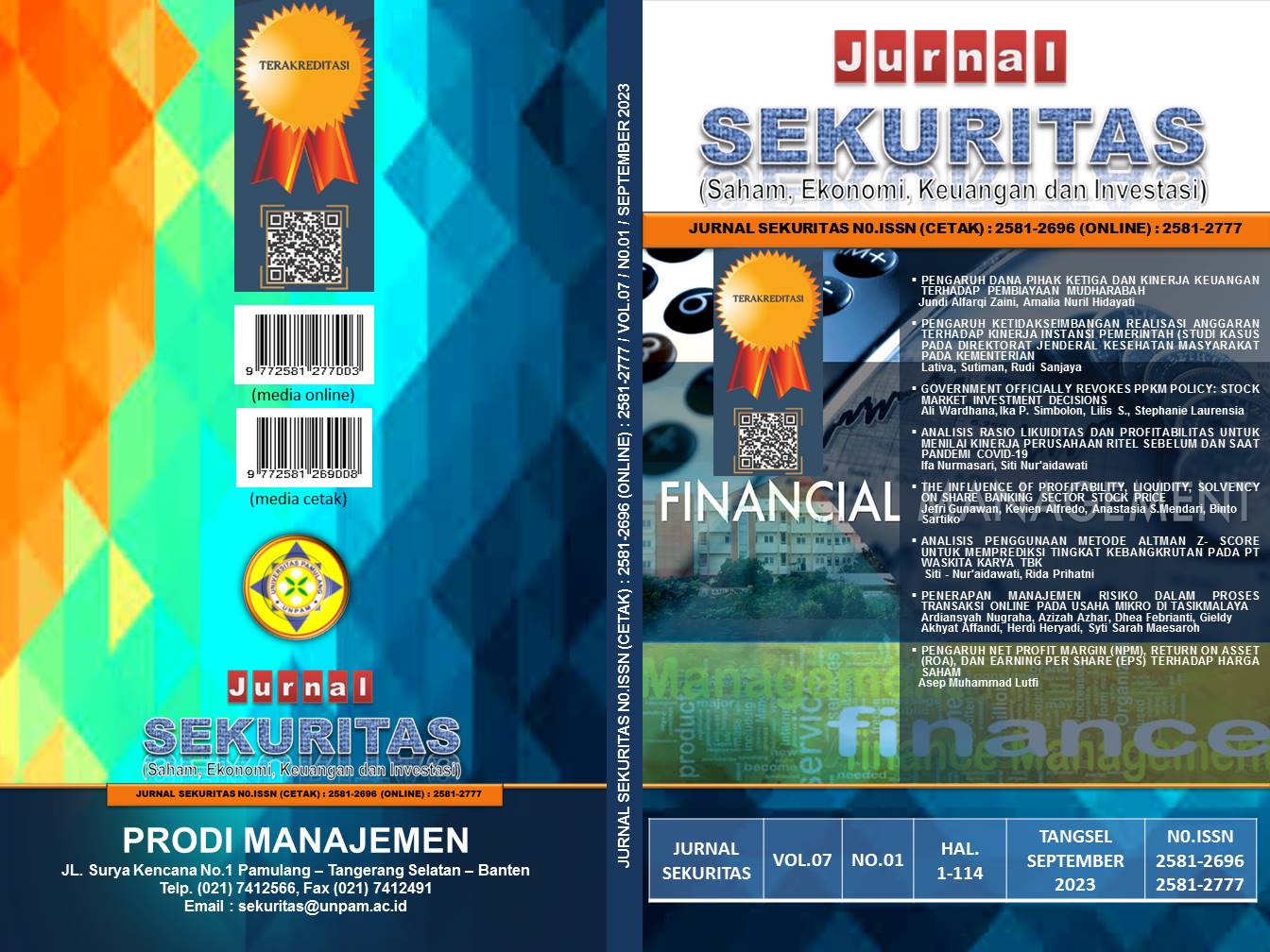Analisis Rasio Likuiditas dan Profitabilitas untuk Menilai Kinerja Perusahaan Ritel Sebelum dan Saat Pandemi Covid-19
DOI:
https://doi.org/10.32493/skt.v7i1.32071Keywords:
current ratio, net profit margin, return on equity, covid-19Abstract
Penelitian ini bermaksud untuk mengevaluasi kinerja keuangan perusahaan ritel di Indonesia dari tahun 2017 hingga 2021, pada masa ekonomi normal dan krisis. Penelitian ini fokus pada analisis rasio likuiditas dan profitabilitas perusahaan. Metode yang digunakan dalam penelitian ini adalah deskriptif kuantitatif dengan menggunakan data sekunder berupa neraca dan laporan laba rugi dari tahun 2017 hingga 2021. Rasio likuiditas yang dianalisis terdiri dari current ratio dan quick ratio, sedangkan rasio profitabilitas meliputi net profit margin dan return on equity. Proses penelitian dilakukan dengan membandingkan rasio keuangan setiap perusahaan ritel yang terdaftar di Bursa Efek Indonesia pada periode yang diteliti dengan rata-rata rasio tersebut. Dari hasil analisis rasio likuiditas dan profitabilitas, terlihat bahwa perusahaan RALS menunjukkan kinerja keuangan yang lebih baik daripada rata-rata perusahaan lainnya, baik pada saat ekonomi berada dalam keadaan normal maupun dalam situasi krisis.
This study intends to evaluate the financial performance of retail companies in Indonesia from 2017 to 2021, during normal and crisis economic times. This study focuses on the analysis of liquidity ratios and company profitability. The method used in this research is quantitative descriptive using secondary data in the form of balance sheets and income statements from 2017 to 2021. The liquidity ratios analyzed consist of the current ratio and quick ratio, while the profitability ratio includes net profit margin and return on equity. The research process was carried out by comparing the financial ratios of each retail company listed on the Indonesia Stock Exchange in the period studied with the average ratio. From the results of the analysis of liquidity and profitability ratios, it can be seen that RALS companies show better financial performance than the average of other companies, both when the economy is in normal conditions and crises.
References
Hery. (2015). Analisis Kinerja Keuangan. Jakarta : Grasindo.
Hery. (2016). Analisis Laporan Keuangan. Jakarta : Grasindo.
Husain, T., & Sunardi, N. (2020). Firm's Value Prediction Based on Profitability Ratios and Dividend Policy. Finance & Economics Review, 2(2), 13-26.
Irham, F. (2016). Manajemen Keuangan. Bandung : Alfabeta.
Kadim, A., & Sunardi, N. (2022). Financial Management System (QRIS) based on UTAUT Model Approach in Jabodetabek. International Journal of Artificial Intelligence Research, 6(1).
Kasmir. (2019). Pengantar Manajemen Keuangan (7th ed.). Jakarta : Kencana.
Khair, O. I. (2020). Analisis Rasio Likuiditas, Rasio Aktivitas Dan Rasio Profitabilitas Untuk Menilai Kinerja Keuangan Pada Pt Astra Otopartstbk Periode (2008-2017). Jurnal Ilmiah Feasible (JIF), 2(2), 157. https://doi.org/10.32493/fb.v2i2.2020.157-167.6155
Muslim, M., & Yani, Y. I. (2019). ANALISIS RASIO AKTIVITAS DAN RASIO SOLVABILITAS UNTUK MENGUKUR KINERJA KEUANGAN (Studi kasus pada PT. Gudang Garam, Tbk. Thn. 2013-2017). Jurnal SEKURITAS (Saham, Ekonomi, Keuangan Dan Investasi), 2(2), 98. https://doi.org/10.32493/skt.v2i2.2493
Nardi Sunardi Et Al (2020). Determinants of Debt Policy and Company’s Performance, International Journal of Economics and Business Administration Volume VIII Issue 4, 204-213
Nurmasari, I., & Sukmana, A. (2019). ANALISIS AKTIVITAS DAN PROFITABILITAS UNTUK MENILAI KINERJA KEUANGAN PT MIDI UTAMA INDONESIA TBK (Dibandingkan Dengan Perusahaan Ritel yang Terdaftar di BEI). Jurnal Forkamma, 2(3).
Oktariansyah, O. (2020). Analisis Rasio Likuiditas, Solvabilitas dan Profitabilitas Dalam Menilai Kinerja Keuangan Pada PT. Goldman Costco Tbk Periode 2014-2018. Jurnal Media Wahana Ekonomika, 17(1), 55. https://doi.org/10.31851/jmwe.v17i1.4336
Priyanto, A. A., & Saleh, I. D. (2019). Analisis Rasio Likuiditas, Solvabilitas, dan Profitabilitas Dalam Mengukur Kinerja Keuangan Pada Perusahaan PT Fast Food Indonesia, Tbk Tahun 2013-2017. Jurnal Madani : Ilmu Pengetahuan, Teknologi, Dan Humaniora, 2(2), 248–257. https://doi.org/10.33753/madani.v2i2.70
Salim;, & Haidir. (2019). Penelitian Pendidikan: Metode, Pendekatan dan Jenis. Jakarta: Kencana.
Shabrina, N. (2019). Analisis Rasio Profitabilitas Dan Rasio Likuiditas Untuk Menilai Kinerja Keuangan Pada Pt. Astra Internasional,Tbk. JIMF (Jurnal Ilmiah Manajemen Forkamma), 2(3), 62–75. https://doi.org/10.32493/frkm.v2i3.3398
Sugiyono. (2016). Metode Penelitian Kuantitatif, Kualitatif, dan R&D. Alfabeta.
Sugiyono. (2017). Metode Penelitian Kuantitatif, Kualitatif dan R&D. Yogyakarta : Alfabeta.
Sujarweni. (2015). Metodologi Penelitian–Bisnis & Ekonomi. Yogyakarta : Pustaka Baru Press.
Sunardi, N., & Tatariyanto, F. . (2023). The Impact of the Covid-19 Pandemic and Fintech Adoption on Financial Performance Moderating by Capital Adequacy . International Journal of Islamic Business and Management Review, 3(1), 102–118. https://doi.org/10.54099/ijibmr.v3i1.620
Downloads
Published
Issue
Section
License
Open Access
Jurnal SEKURITAS (Saham, Ekonomi, Keuangan dan Investasi) is a national peer reviewed and open access journal that publishes significant and important research from all area of agroindustry.
This journal provides immediate open access to its content that making research publish in this journal freely available to the public that supports a greater exchange of knowledge.
Copyright
Submission of a manuscript implies that the submitted work has not been published before (except as part of a thesis or report, or abstract); that it is not under consideration for publication elsewhere; that its publication has been approved by all co-authors. If and when the manuscript is accepted for publication, the author(s) still hold the copyright and retain publishing rights without restrictions. Authors or others are allowed to multiply article as long as not for commercial purposes. For the new invention, authors are suggested to manage its patent before published. The license type is CC-BY-SA 4.0.
Disclaimer
No responsibility is assumed by publisher and co-publishers, nor by the editors for any injury and/or damage to persons or property as a result of any actual or alleged libelous statements, infringement of intellectual property or privacy rights, or products liability, whether resulting from negligence or otherwise, or from any use or operation of any ideas, instructions, procedures, products or methods contained in the material therein.















